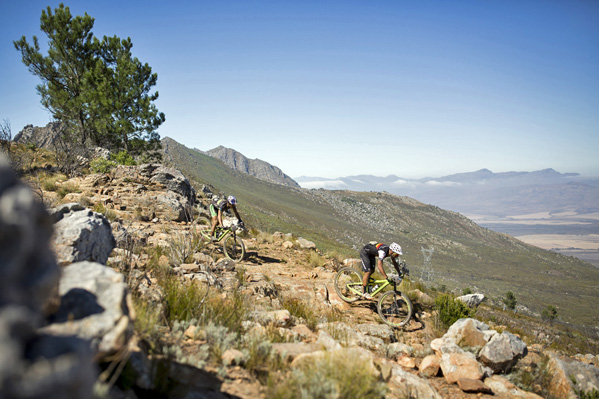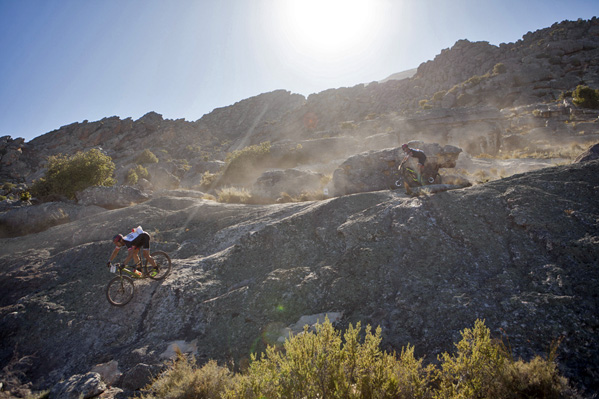There was a fairly high percentage of teams that did not finish the 2016 Absa Cape Epic and the difficulty of the route seemed to be the most popular reason/excuse. We include the word excuse because participants seldom volunteer self-blame when they can’t finish a Cape Epic. But the 2016 Cape Epic route was the first one that really was a proper mountain bike route. Here’s why…
By Sean Badenhorst

Photo: Nick Muzik/Cape Epic/SPORTZPICS
Sure, there are a few really bad luck cases that force riders out of the race, either through mechanical failure or illness. But most of the other reasons for withdrawal before the finish are avoidable/manageable; and it’s simply a case of being under prepared/conditioned.
Mountain bike stage racing should test a combination of endurance, bike-handling skill, recovery, equipment choice, energy management, partner relationship management and time management. You can still finish with one or two of these areas not being up to scratch, but once a few of them are out of control, faltering and failing becomes more likely.

Photo: Gary Perkin/Cape Epic/SPORTZPICS
Traditionally, Stage 1 offers the big Cape Epic reality check. The Prologue is always short and exciting and a great way to get the nerves under control and iron out any last minute niggles. But Stage 1 is usually a big day in the saddle that sees the first real fallout. These are usually riders that are simply not conditioned enough.
But while Stage 1 this year was a tough one, the biggest stage ‘cull’ occurred on Stage 3, the 101st Cape Epic stage to be ridden. The 104km stage from Saronsberg to Wellington included 2150 metres of ascent, with much of that coming in the second half of the stage. There was also a headwind, some sections of thick sand and of course hot, dry weather, all of which made for a challenging day out. Combine that with two long preceding stages and you get one of the biggest DNF days in the race’s history. A total of 61 teams succumbed on Stage 3. That’s almost a tenth of the field. For a comparison, 32 teams failed to finish Stage 3 in 2015, the toughest stage of that edition.
Mountain bike racing isn’t meant to be easy, but there are days when it

Photo: Dominic Barnardt/Cape Epic/SPORTZPICS
really can be super tough. Stage 3 in 2016 was one of those days. A day when even seasoned riders find themselves wondering why they’re putting themselves through this – voluntarily.
As we wrote before the 2016 race, the Cape Epic is a race, not a ride. An international level race of the highest grading, designed to create a challenging contest between the world’s best professional racers. The rest of us get a rare opportunity to be a part of that race and should really prepare properly, no matter how difficult it may be.
This 2016 race included a lot of rough-surface singletrack, especially in the first half. Modern mountain bikes are designed for this kind of terrain, but it can really be a challenge if you don’t know how to ride it with at least a basic level of confidence. Many Cape Epic participants focus heavily on training their endurance, but place little or no emphasis on their skills. Maybe that will change after this year’s route design.
Will the organisers feel bad about the tough route of 2016 and offer a less challenging route in 2017? We hope not, although, by the look of it (on paper), it seems a little less formidable than 2016’s route. Mountain bikers really should take this event seriously and get to the start line prepared enough to be able to make it to the finish line – the final stage finish line…
Average speeds and finishing times
We started collating this information a couple of years ago to determine the depth of quality in the Cape Epic fields. Taking the winners as the benchmark, we have noted the time of the 100th placed team as well as their time behind the overall winning team. Obviously route distance has an effect on these numbers, but average speed is the best reflection of the conditions in general.
Note that even though the 2016 route was the shortest, the average speed was the second slowest of all 13 editions (and the slowest since the introduction of 29-inch wheels). This is an indication that the terrain, gradient and higher percentage of singletrack all had an effect on the race speed, emphasising too the importance of power and skill, not only endurance and recovery, which were the primary factors in the early years, especially on the point-to-point route, which included a higher percentage of gravel roads.

Photo: Sam Clark/Cape Epic/SPORTZPICS
Also see that in 2016, the gap to the 100th team from the winners was the smallest yet. This indicates that the depth of the top 100 teams was the greatest so far (factually), which could be interpreted as race preparation among the more serious participants is improving.
Finishing stats since Race #1:
2004 – winners: 31:02:55 / 25.37kph | 100th position: 44:48:51 (@13h46m)
2005 – winners: 31:20:06 / 28.65kph | 100th position: 46:38:53 (@15h18m)
2006 – winners: 34:41:41 / 27.08kph | 100th position: 49:04:07 (@15h22m)
2007 – winners: 33:08:00 / 26.74kph | 100th position: 46:30:49 (@13h22m)
2008 – winners: 36:01:44 / 26.80kph | 100th position: 50:13:45 (@14h12m)
2009 – winners: 28:10:13 / 26.41kph | 100th position: 38:53:37 (@10h43m)
2010 – winners: 29:47:46 / 22.18kph | 100th position: 41:10:43 (@11h22m)
2011 – winners: 28:44:44 / 24.62kph | 100th position: 39:08:39 (@10h23m)
2012 – winners: 31:46:50 / 24.38kph | 100th position: 44:00:02 (@12h46m)
2013 – winners: 29:40:44 / 23.78kph | 100th position: 40:03:39 (@10h22m)
2014 – winners: 30:31:59 / 23.51kph | 100th position: 40:06:06 (@9h28m)
2015 – winners: 31:00:57 / 24.61kph | 100th position: 41:11:39 (@10h10m)
2016 – winners: 28:13:28 / 23.17kph | 100th position: 37:10:08 (@08h56m)



